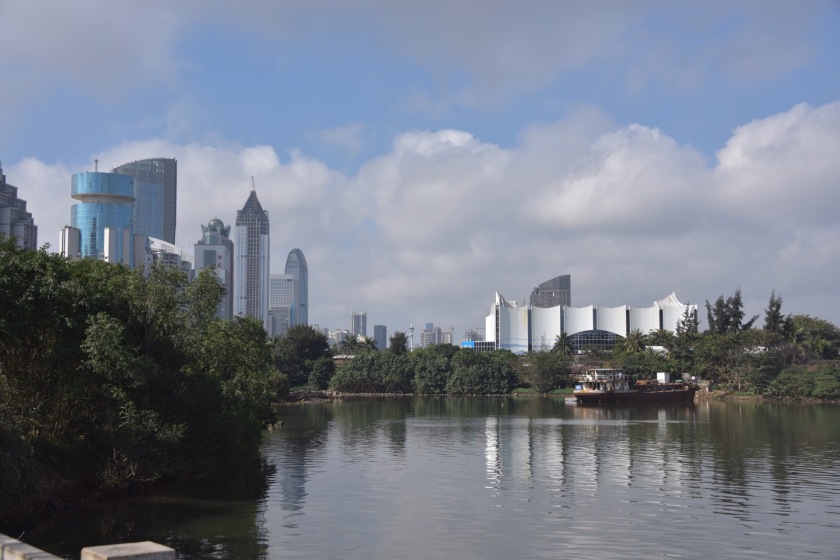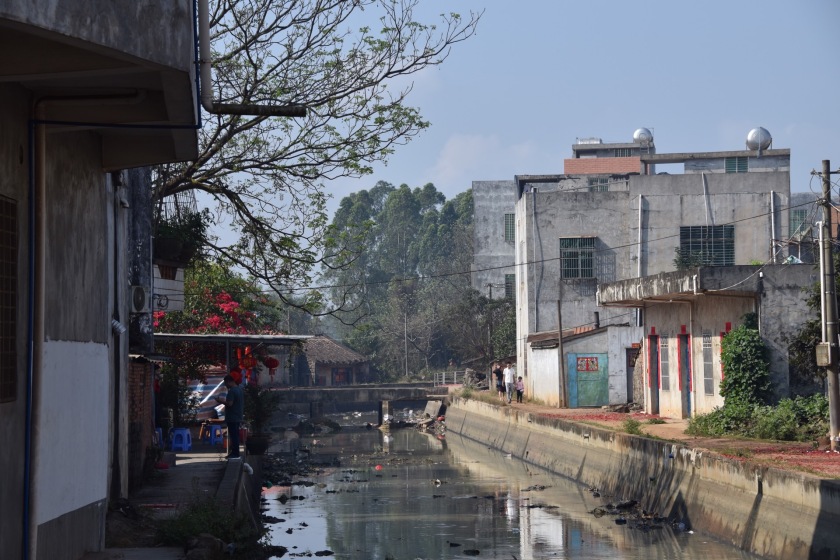
It is few visible that Hainan province has been recognized as a non-developed region, still about 25 years ago. Haikou and Sanya are big cities, that are booming as other cities in China do, too. Maybe the activity in building construction is even higher here, as the province still has a special status as a region of economic development. Tourism is a growing sector, too, that also still is pushed by the government. The Chinese adopted this island already as their tropical paradise.
Now, in the beginning of February are lots of tourists here and also people who come home to their families from all provinces, because of the upcoming Chinese New Year. I recognise this not only of the traffic.
The coastal highway that goes from Haikou to the west first consists of six and later still of four lanes, and the multi-purpose lane right beside the main road becomes a bike lane, once out of the city. A nice separation – which is not respected consecuently. Even it should be used only in one direction, people with their motorbikes as well as with their cars go in and out and drive in both directions. No-one gives a penny to this behavior, but everyone uses the horn instead, to give signal that one is coming.
A behavior that I have to get familiar with, as well as with the obligation of the cyclist to use pedestrian road crossings. But finally it is much more relaxing to use the main road with the bicycle, instead of this multi-purpose lane.
After we have left the harbour area and two nearby military facilities, we were passing several beaches and parc areas along the coast, which has been few visible because of fog that came in from the sea. The air above the warm seawater has a high humidity, when it’s touching the cooler landmass in the morning. Later the sun came through the mist and pushed the temperature to warm 28° C. From time to time we have a short break to drink some water or to eat some fruits. To protect my skin from getting burned by the intense sun, I also renew the sunscreen two times per day.
We reach Lingao, our destination for today, in the late afternoon after a journey of 98 km along some beach resorts under construction and several villages far from the main traffic routes. Sometimes the landscape is dominated by agricultural plantations. Besides rice-fields in the plains we pass mainly vegetables and strawberries, on higher plains we see pineapples, bananas and eucalypthus-plantations.
Lingao is a province town in the northwest of Hainan, in about 12 km distance from the coast. Dense and vibrant in its center is it a city under construction, where some roads get more space for more traffic, and where the peripherils are constructed in a regular order. Leaving the city to the north brings you quickly into ghost town like districts, where the roads still lead into nowhere and 20-floor buildings are still under construction and inhabited by no-one. Even directly on the coast a complete small town is erected from scratch and put – in the real sense of the word – into the sand.
At the end of a peninsula is located a small parc area with a monument that reminds to the liberation of Hainan from the Japanese occupation in World War II, not far from a fishermen village.
The night before Chinese New Years day is getting loud and stuffy. Already during the complete day firworks were burned everywhere, in the near as well as also far away. But at midnight a constant and terrible noise began, in the street and in the nearby sorroundings. The explosions are much louder than of german fireworks and quickly the dense smoke is roaming not only through the streets, but also upstream between the buildings, so I close the door to the balcony and keep it closed for the rest of the night. No sleep for the next hours and I’m also still hanging on my jet lag.
From Lingao we continue south, first along one of the busiest country roads, over a highway that leads around the island and after about 18 kilometers on a side road and then along some dirt roads through a bit hilly landscape with a partly dense vegetation. From an artificial reservoir go some water-feeding channels which apparently feed a wide branched irrigation network. Around the village of Nabao is located other agricultural land, which is apparently supplied in this way with water.
It is now time for a longer break, after about 40 km route and also the hunger is coming up. Here in Nabao we find a small street kitchen where we get served bread on a spit and spinach vegetables, marinated in a delicious sweet and spicy sauce. It’s also the only alternative on this early afternoon.
Here in town, as well as again along the previous route, can be heard firecracker sporadically. The burning of fireworks has not ended with the New Year’s Eve, but apparently only started and in many places chains of firecrackers be sold in large, red and yellow decorated packaging on the street.
[galleryids=”1050,1053,1049,1054,1059,1058,1052,1060″type=”rectangular”]
Nadao we reach after 67 kilometers through this varied but sometimes hilly landscape, the afternoon heat is already a bit behind. The traffic is manageable on this holiday, the bus terminal, which we pass, is closed. The city is the seat of the provincial government, whose representative building is located on the edge of the city center in the midst of a large, guarded park.
Later, in search of a downtown restaurant, we also walk by this park and a young man speaks to me in very broken English. He would run an international language school and is looking for a new English teacher – asks me if I don’t want to stay the same. But I can only disappoint him.















